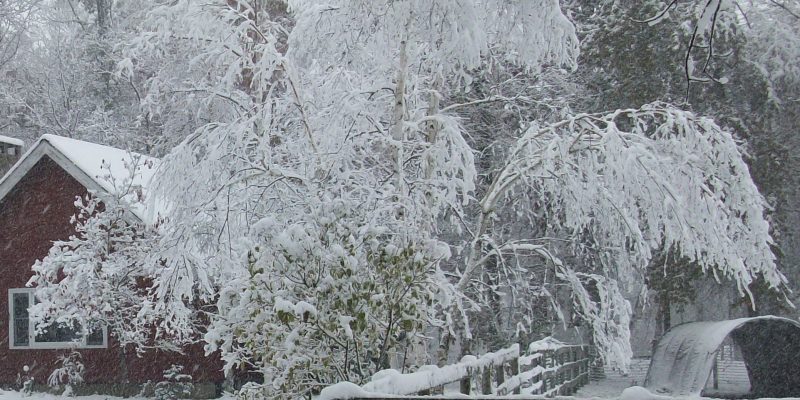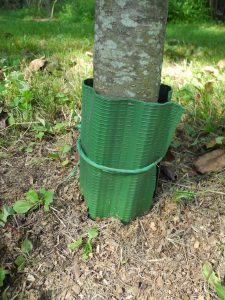
Did you plant a tree on Arbor Day last April? I did, and after nurturing and watering it all summer, now I’m making sure it will be prepared for the winter. Young trees, and others as well, do better when a few easy steps are taken to protect them from freezing temperatures, hungry rodents, and winter conditions. So let’s get started …
Mulch: All trees benefit from an inch or two of mulch, spread around for a foot or more from the stem, year round. In summer, it protects the soil from drying out, discourages weeds, and looks good, too. In winter, mulch provides protection from freeze-thaw cycles, which can literally lift a small root ball right out of the soil.
Mulch can be most any organic matter, peat moss, wood chips or sawdust, well decayed garden material, even grass clippings. Newspaper can be used also, directly on the ground, and covered with a thin layer of organic matter, to hide it. Whatever, be sure to mulch your tree before the ground freezes, and don’t mound it up around the trunk, like a tree sprouting from a mini-volcano. Leave it shallow next to the trunk; mice, shrews and other rodents burrow beneath the snow, and are always looking for something succulent in the midst of the cold season. What better than the inner back of a nice, healthy young tree, found at the end of a thick mulch tunnel? Rodents may completely gnaw around the circumference of the tree, girdling it, so that the tree will not grow the following spring.
Trunk protection: In addition to attack by rodents in the winter, young trees are especially vulnerable to the common string weed whacker. When hit by the strings, the bark can be stripped away, right down through the cambium layer beneath, which is the only living part of the trunk of a tree. The last mowing of the season may be especially dangerous to young trees. 
Protection is easy. Several types of “Trunk Protectors” are readily available at garden centers, or you could make one yourself out of hardware cloth or edging material. These should be six or eight inches tall, wrapped around the base of the tree, down to and slightly into the soil itself. Make sure it completely encloses the tree; no gaps. Keep them in place all year long. As the tree grows, additional sections may have to be added, but once a tree is about six inches in diameter at the ground, the bark is probably thick enough that you can relax with the trunk protector.
Wind Damage: Most new trees planted with a root ball are firm enough in the ground and can withstand typical winter windy conditions, especially with the leaves gone. Trees planted “bare root” may be susceptible to damage from gusty winds in winter. Also, a tree with a large set of branches, or a new tree in an exposed and very windy location, will benefit by providing support for the stem with tall stakes. Two stakes are better than one, driven into the ground a foot or so from the stem of the tree. Use a couple of short pieces of old hose or similar cushioning on the rope or wire to protect the bark. Leave a bit of slack, so the tree can move a little, which will encourage root formation. After a year, the stakes can be removed.
Drought: While mulch will help, the tree will still need water, even after the leaves fall. If very dry conditions continue through the fall, be sure to water new trees (and shrubs, too), before the ground freezes. Roots will need water to allow them to survive the winter.
Heavy Snow and Ice: Heavy, wet snow, typical of early or late storms, can bend a small tree to the ground, or snap it part way up. Little can be done in advance, but going out in the storm, or right afterward—yes, a winter challenge for us all—and brushing or shaking the snow off may make the difference in a tree’s survival, and certainly in its appearance. Brooms or dusters on long handles work well. Don’t wack the branches with sticks. Some trees, like white birch and willow, are highly susceptible to snow damage so be especially watchful, and act promptly to clear them off. Small trees bent over may remain that way, and may need to be propped up for a year or so with long wooden stakes. Ice is another matter and, fortunately, fairly rare in Gardiner. A thin coating of ice will probably melt at the first sunny day, but little can be done about a thick coating. Ice won’t brush off, and shaking a tree coated with ice will probably only produce a fall of broken branches, small and large. Best to leave things be, and hope for the best.
Older Trees: Trees grow surprisingly fast. Soon, small trees tower over us, and get thicker year by year. Older trees need little attention, summer or winter, and once so tall as to be out of easy reach, cannot be helped much, except by professional tree climbers and arborists. Should heavy snow from an early or late storm, or a rare destructive ice storm, produce a lot of broken branches, you might consider hiring an arborist or tree care professional to trim or re-balance an especially valuable or favorite yard tree. Otherwise, trees have survived many a winter, thank you, and can be expected to recover by themselves in the years to come.
